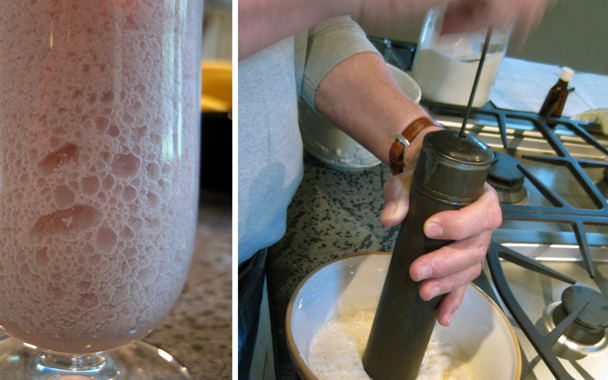My grandmother, who grew up in Chattanooga and Savannah and finally settled in Gainesville, Florida, had both a hybridized southern accent and a habit of referring to things by names she’d given them. For instance, she always referred to oxford shirts as button-up-the-front shirts and what most people call ambrosia was simply pineapple salad to her. So, last fall, when she was describing a boozy holiday beverage her family made during her childhood, I assumed that sillybub, as I recorded it, was probably the product of her charming, if obscuring, accent and vernacular.
My father, who has only an indiscernible southern accent, clarified things by emailing me several family recipes for “Syllabub,” an achingly decadent brew of cream, sweet wine, and sugar. To some extent, these ingredients can vary—muscat, vin santo, and sweet sherry can all be used in the way of sweet wine. What’s immutable is the texture, a fact my father made clear to me when he described his great-grandmother’s syllabub pump: a hollow, tin cylinder, one end of which is freckled with little holes and the other outfitted with a tin plunger. Put the holey end in your mixture, start pumping like your bike tire is flat, and you’ll soon have a batch of syllabub. “What’s the consistency like?,” I asked. “Foamy? Stiff peaks? What?” My father paused, recalibrating his words to match my grandmother’s lilt and verbal creativity, and said, “Oh no. It should be...throffee.”
Indeed, syllabub is ultimately about the pursuit of the perfect aeration method. Dating back to the 16th century, European recipes include frothing techniques like passing the ingredients through a chocolate mill or whipping them with a rosemary branch. (The oldest recipes I found asked you to take your bowl of sugary wine out to the barn and add a sudsy helping of milk directly from your cow.) Other than a couple of 18th-century recipes that mentioned a wooden syringe or “dry cow,” I haven’t uncovered any references to our more modern syllabub pump; so when I recently convinced my father and his wife, Shelley, to do a syllabub tasting with me, I silently wondered if the pump’s prowess wasn’t just based on embellished family lore.
My dad and Shelley have a farm in the mountains of North Carolina; they fill their time there with projects that always make me envious. The afternoon of the syllabub-tasting, for example, my dad was planting rose bushes and Shelley was making a giant pie with apples from a tree near the barn. The recipe I’d selected for us to use was clearly written with a parlor full of guests in mind: It simply called for one quart of heavy cream, one cup of sugar, and two cups of elderberry wine. I halved the cream and sugar and split the mix into two bowls. As I poured some blackberry wine—which was what my grandmother told me she’d used—into one of the bowls, my dad appeared with the syllabub pump.
“Does this look right?” I asked with a new wave of skepticism, tipping the bowl toward my dad so he could see its cotton candy-pink contents.
“Sure,” he said. Then he submerged the pump and started plunging. A new sound filled the kitchen, somewhere between whisking and sucking up that last bit of milkshake with your straw. “This is probably the first time this thing has been used in forty years,” my dad said as peanut-sized bubbles started to appear. Over the next minute—as I kept saying, “It’s totally working!”—my father plunged until there was a three-inch layer of bubbly pink rising up from the bowl. He skimmed, or “heaped” as many syllabub recipes say, several spoonfuls of the bubbles into three trifle glasses. Then we toasted and drank⎯or, actually, we slurped, since, even though our glasses were brimming, most of it was simply air. The bubbles skimmed over my tongue and melted away, leaving behind the light taste, or almost just the suggestion of sweet cream and wine.
We spent the next hour and a half in an experimental frenzy. We tried the same recipe with a Bonny Doon Muscat (my favorite); it tasted more like a dessert beverage than a straight-up piece of candy, and then with a cream sherry (my father’s favorite); very sweet and very boozy. We alternated syllabub tastes with shortbread cookies. Then we nibbled on a spread of cashews, cold eggplant parmigiana, and edamame. At one point, Shelley visited the frost-faded herb garden, and we (pretty unsuccessfully) hand-whipped one batch with a twig of rosemary. We heaped the bubbles over slivers of fresh pineapple. We added lemon juice and rind to another batch and sprinkled the post-plunged product with nutmeg.
By the end, I completely understood how the syllabub pump had survived five generations. The pump doesn’t produce a beverage. It produces a simple thrill: A glass full of lighthearted bubbles that float and pop in your mouth with each throffee slurp.




 Pinterest
Pinterest


